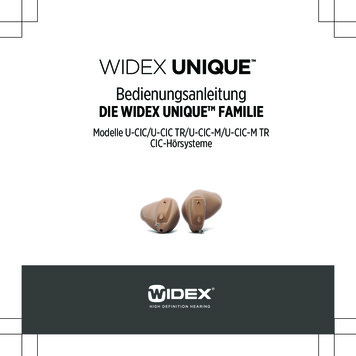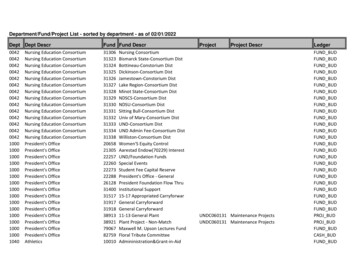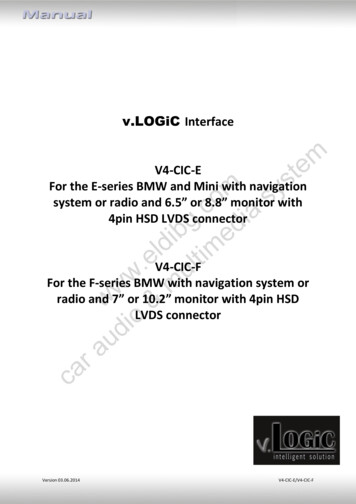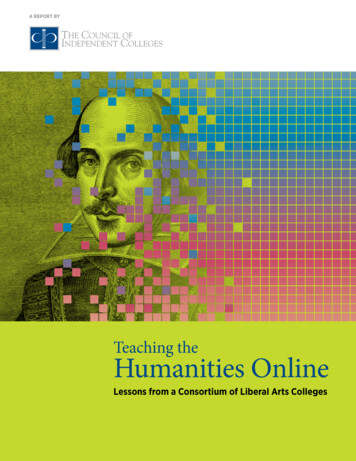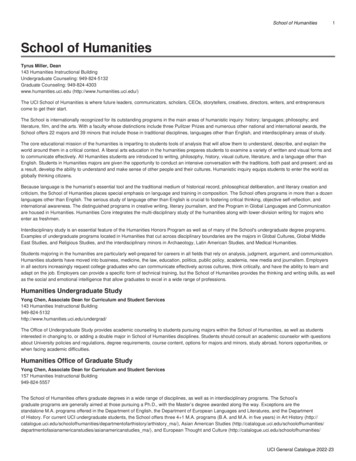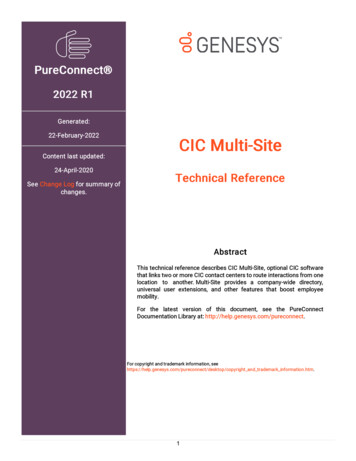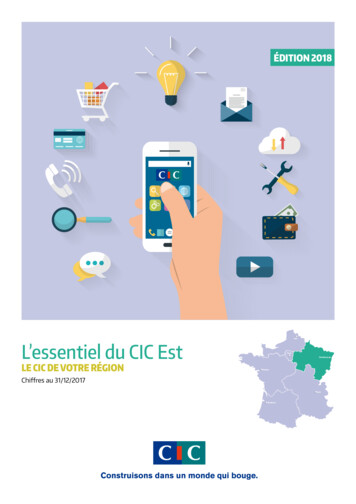
Transcription
REPORTCIC Consortium for OnlineHumanities Instruction II:Evaluation Report for First CourseIterationSeptember 19, 2017Jenna JooDeanna MarcumDaniel Rossman
Ithaka S R provides research andstrategic guidance to help theacademic and cultural communitiesserve the public good and navigateeconomic, demographic, andtechnological change. Ithaka S R ispart of ITHAKA, a not-for-profitorganization that works to advanceand preserve knowledge and toimprove teaching and learningthrough the use of digitaltechnologies. Artstor, JSTOR, andPortico are also part of ITHAKA.Copyright 2017 ITHAKA. This work islicensed under a Creative CommonsAttribution-NonCommercial 4.0International License. To view a copy ofthe license, please see AKA is interested in disseminatingthis brief as widely as possible. Pleasecontact us with any questions about usingthe report: research@ithaka.org.CIC CONSORTIUM FOR ONLINE HUMANITIES INSTRUCTION II: EVALUATION REPORT FOR FIRST COURSE ITERATION1
ContentsIntroduction . 3Preliminary Findings . 4Data Sources. 9Limitations . 11Description of Courses and Participants . 12Instructor Experience . 15Student Experience . 20Student Learning Outcomes . 25Overall Assessment .27Stakeholder Interviews . 33Preparing for the Next Iteration of Courses . 34Conclusion . 36Appendix A: List of Data Elements Requested.37Appendix B: Rubric for Peer Assessment . 38Appendix C: Instructor Survey . 40Appendix D: Student Survey. 48Appendix E: Interviewee List and Interview Scripts . 51CIC CONSORTIUM FOR ONLINE HUMANITIES INSTRUCTION II: EVALUATION REPORT FOR FIRST COURSE ITERATION2
IntroductionThe CIC Consortium for Online Humanities Instruction began in 2014 with the supportof The Andrew W. Mellon Foundation. The success of the first Consortium motivated theMellon Foundation to support a second Consortium that was formed in the summer of2016 with teams of faculty members and administrators from 21 institutions that wereselected through a competitive process.1 Each institution is represented by a fourmember team including a senior academic administrator, two full-time faculty membersin the humanities, and the registrar or representative from the registrar’s office.The report that follows documents the experience of the 21 participating institutionsduring the first year of the Consortium II initiative. The data refer only to the coursesdeveloped for the project and the reactions of faculty and students to those courses.While it may be interesting in future reports to compare the experiences of ConsortiumII to those of Consortium I, comparisons are not included here.The initial round of online courses developed for this Consortium was offered during theSpring 2017 semester. Courses will be revised and opened for enrollment by studentsfrom the other participating institutions during the 2017–2018 academic year. Thisinterim report documents the first year experience of the second Consortium.The CIC Consortium set out to address three goals:1. To provide an opportunity for CIC member institutions to build their capacity foronline humanities instruction and share their successes with other liberal artscolleges.2. To explore how online humanities instruction can improve student learningoutcomes.3. To determine whether smaller, independent liberal arts institutions can make moreeffective use of their instructional resources and/or reduce costs through onlinehumanities instruction.The 21 participating institutions in CIC Consortium II are: Bloomfield College (NJ), Carlow University (PA), Carroll College (MT),Carroll University (WI), Claflin University (SC), Clarke University (IA), Concordia University Texas (TX), Gettysburg College (PA),Lasell College (MA), Mount Mary University (WI), Northwestern College (IA), Randolph-Macon College (VA), Rosemont College(PA), Shenandoah University (VA), Siena College (NY), Simpson College (IA), St. Edward’s University (TX), St. Olaf College (MN),Ursuline College (OH), Walsh University (OH), and Wesleyan College (GA).1CIC CONSORTIUM FOR ONLINE HUMANITIES INSTRUCTION II: EVALUATION REPORT FOR FIRST COURSE ITERATION3
Preliminary FindingsAt the end of the first year of Consortium II, the participating institutions have achieveda great deal towards each goal:Goal 1: Building CapacityHigher education is experiencing rapid change. Online instruction, once relatively rare inthe independent sector of higher education, has become more common in just the pastfew years. When the first Consortium began in 2014, 75% of the participating facultymembers had never taught an online course. Consortium II faculty who began in 2016were considerably more experienced. Twenty-one (21) of the 39 (60%) respondingfaculty members had taught at least one online course previously, and many of them hadtaught several such courses. (In part, this was the result of a deliberate change in theselection process for participating institutions.)The 42 faculty in Consortium II offered 39 online or hybrid courses in Spring 2017.(Because of local circumstances, two courses were offered in face-to-face mode and onewas shifted to Fall 2017.) In selecting institutions to participate in the second round ofthis project, special attention was given to those who proposed to create courses thatcould be widely used by others in the Consortium. Seventeen faculty created entirely newonline courses, 21 modified an existing face-to-face course, and one enhanced an existingonline course. More students in Consortium II than Consortium I had already beenexposed to online learning, as well. Sixty-five percent of the 320 responding students hadtaken one or more online or hybrid course before the Spring 2017 semester.Faculty in Consortium II were comfortable with the technical challenges of onlinelearning. Most faculty (88%) had participated in some kind of training for onlineteaching, before or during the initial year of this project. Nearly 75% of faculty reportedhaving access to instructional designers and/or instructional technologists to assist withdesigning and developing their courses, which was a clear value added for someinstructors. And nearly all faculty felt adequately prepared to teach online or hybridcourses.These findings indicate that most Consortium II participants are developing experiencewith online teaching and learning, are able to allocate resources to support onlineteaching, and are growing more comfortable with it.CIC CONSORTIUM FOR ONLINE HUMANITIES INSTRUCTION II: EVALUATION REPORT FOR FIRST COURSE ITERATION4
Goal 2: Enhancing Student LearningA central question for this project is how effective are online and hybrid courses inpromoting student learning. Most of the online courses in Consortium II did not haveface-to-face counterparts, so it was not possible to conduct a rigorous comparison ofstudent learning outcomes. Instead, we asked faculty to assess their own students’learning and compared their responses to peer assessments conducted by a group of sixhumanities faculty from other Consortium institutions. Randomly selected faculty wereasked to submit student artifacts that illustrated a command of certain learningobjectives. Student work was collected based on a formula for ensuring objectivity. Theresults revealed that instructors and peer evaluators were closely aligned in theirassessment that students demonstrated satisfactory mastery of learning objectives.To the extent that course grades are an indicator, courses in Consortium II looked verypromising, as over 80% of students in 19 institutions passed their courses with about55% of them earning A’s. The withdrawal rate in Spring 2017 was also low; over 90% ofConsortium students (n 546) remained enrolled throughout the term.Student engagement is highly prized by liberal arts colleges, and understanding the levelof social presence in the online environment is critical to measuring the success of onlinecourses in the liberal arts. An interesting finding to note is that many instructorsexpressed dissatisfaction with the level of social engagement and sense of communitybuilding among students while the students, for the most part, were quite satisfied withthe level of social presence in their online courses.When we asked students to evaluate their experience with the courses and to comparethem to traditional in-person courses they had taken, of 280 students responding, 81%rated the experience as good or very good; only 19% rated the experience as fair or poor.Eighty-six (86) students thought the online course was about the same as traditionalcourses they had taken and 125 rated the online courses as somewhat better or muchbetter than traditional in-person courses.Thirty-one (31) of the 39 responding faculty indicated their overall assessment of theappropriateness of the online/hybrid format for teaching advanced humanities contentto be somewhat appropriate or appropriate, while three indicated not appropriate. Fourindicated that it was too early to tell.CIC CONSORTIUM FOR ONLINE HUMANITIES INSTRUCTION II: EVALUATION REPORT FOR FIRST COURSE ITERATION5
Students who ranked online/hybrid courses better cited a number of reasons for theirresponse, the most common of which was the increased flexibility that online/hybridcourses afforded. One student wrote:I have a busy life outside of school, so online classes are easier for me tocomplete.Another wrote:I thought I could complete the requirements early in the semester.Faculty also rated online teaching positively:In this particular course, we often tackle controversial issues. In the face-to-facecourse, I often find students rather reticent to enter into discussion. The onlinestudents seemed to have no reticence at all. I did have to offer constant guidanceabout how postings should be based on the course texts and concepts and notjust an opportunity to express opinions. But, overall, I was pleasantly surprisedby the display of enthusiasm with which the students participated, and thatenthusiasm seemed to last through the entire course Online learning, taking into account all of the data we collected, has a number of benefitsfor student learning. Students appreciated the convenience of online courses, but theywere surprised to learn that in many respects, such courses are more demanding thantraditional face-to-face courses. When faculty were asked to assess the appropriatenessof online learning for teaching advanced humanities content, 80% said online methodsare appropriate or somewhat appropriate.The one disadvantage to online instruction noted by both students and faculty is the lossof some personal interaction between the two groups. This may be especially importantin online courses designed to substitute for highly interactive seminars.Goal 3. Increasing EfficiencyThis goal has been the hardest to evaluate. When the first Consortium was launched in2014, we asked all the participating faculty members to record their time spent ondeveloping and delivering online and hybrid courses. Our intention was to measure costsavings over time. The experience of the first Consortium helped us understand thatcollecting timesheets from faculty was not productive. It is clear that online and hybridcourses entail additional start-up costs in terms of faculty planning time and supportcosts, not to mention the technology infrastructure. Eventually we may be able toCIC CONSORTIUM FOR ONLINE HUMANITIES INSTRUCTION II: EVALUATION REPORT FOR FIRST COURSE ITERATION6
determine if having online courses available for students will allow colleges to offeradditional courses without adding faculty costs, but calculating such savings is notpossible at this time. While instructors may well save time in the second iteration ofoffering these courses, faculty at the end of the first year’s experience reported thatplanning and developing online courses certainly took more time.This is consistent with other research. Of the 39 faculty responding to the Consortium IIsurvey, only two thought that developing online courses takes the same amount of timeas developing a comparable face-to-face course. Thirty-seven (37) reported that whencomparing the two delivery modes, online courses take more time or much more time.When thinking about the time it takes to teach online courses, compared to face-to-facecourses, the results were similar. Three instructors thought online courses took muchless time; 14 thought they took about the same amount of time; 22 thought the onlinecourses took more time or much more time to teach. When courses are offered to othersin the Consortium in the second year of the project, we will be able to make moredefinitive statements about achieved efficiencies.Preliminary ConclusionOur preliminary conclusion from the first iteration of courses is that online learning canbe an appropriate format for delivering upper division humanities courses. Evidencefrom the first iteration of courses indicates that online instruction can be implementedsuccessfully and, under the right circumstances, in ways that are consistent with themission and goals of liberal arts institutions. Students appreciate the flexibility affordedby such courses and their learning outcomes are similar to those achieved in traditionalclassroom courses. While faculty are concerned that student engagement is not as strongin online courses as in face-to-face courses, students rated engagement in online coursesto be the equivalent of engagement in traditional courses. The next iteration of thesecourses will provide an opportunity to further interrogate these findings and, inparticular, to investigate the impact and feasibility of cross-enrollment within the CICConsortium.Takeaways from the Workshop in August 2017Participants in the workshop held at the conclusion of the Consortium’s first year inWashington, D.C., on August 7-9, 2017, confirmed the findings of our evaluation. Someof the key takeaways that emerged from the workshop presentations and discussionsinclude:CIC CONSORTIUM FOR ONLINE HUMANITIES INSTRUCTION II: EVALUATION REPORT FOR FIRST COURSE ITERATION7
Many of the workshop participants agreed that comparing online versus face-toface courses with just the standard learning outcome metrics, such as final coursegrades, is not very productive. Online courses offer different ways of engagingwith the course and require different preparation and tools for both students andinstructors. Many instructors realize that a large number of today’s students are not“traditional.” Many are older, live off campus, work full-time, have extensivefamily commitments, and seek alternative credential programs. Consequently,the instructors and administrators recognize that the level of convenience andflexibility that online courses offer to students is an important factor to consider. Many instructors believe that part of their responsibility as educators is toprepare students for the digital world. Some argued that not providing studentswith opportunities to engage in online learning would put them at a disadvantageespecially students who already lag behind in such experience. The Consortium experience allowed instructors to rethink their pedagogicalapproaches by becoming more intentional and deliberate about what they want toaccomplish in their courses. Many expressed that teaching online helpedchallenge fundamental assumptions about teaching and learning that they oftenemploy in their traditional classes. The Consortium experience allowed instructors to think more holistically aboutassessing student learning. In addition to coming up with creative ways forstudents to engage with the course contents (e.g., gamifying the entire course)and demonstrate what they have learned (e.g., providing multiple options forcompleting assignments), the instructors have begun to rethink what constitutes“student engagement,” recognizing that there are various ways that students canengage with one another in digital spaces. The participants agreed that there is a need for rethinking current humanitiescurricula and course offerings to better meet the needs of the students in a worldthat is constantly in flux. For some participants, this also means dealing directlywith resistance from their colleagues, who are skeptical about the idea of usingtechnology to enhance quality of learning and increase efficiencies in ways thatdo not adversely affect faculty positions.CIC CONSORTIUM FOR ONLINE HUMANITIES INSTRUCTION II: EVALUATION REPORT FOR FIRST COURSE ITERATION8
Some questions that the Consortium institutions will continue to grapple with during thenext year are: How can they work collaboratively to identify expertise gaps in each institutionand share faculty talent effectively in order to ensure that students will trulybenefit from the rich array of advanced humanities courses offered byConsortium institutions? How can they provide adequate levels of support for faculty to develop theircapacity to teach in new digital environments, in ways that are empowering andenriching? And how can they continue to work together to develop effective strategies fortackling some of their most pressing institutional problems in the face of achanging economy (including a decline in student interest in the humanities)?Data SourcesIn order to assess the Consortium’s success in achieving each of its explicit goals, wecollected data from multiple sources. These include: Registrarial Data [N 20 institutions]. Student-level registrarial data werecollected from Consortium courses of each institution at the end of Spring 2017term to report course enrollments, course completion rates and gradedistributions. Course-level registrar data on the total number of courses offeredin-person and online at each institution as well as institutional spending oninstruction were also collected (the same data reported to IPEDS2). For moreinformation about the specific data elements we requested from the institutions,see Appendix A. Faculty Peer Assessment Scores [N 63 artifacts, 498 scores]. Fifteen(15) randomly selected instructors were asked to designate artifacts from threerandomly selected students in their courses to serve as evidence of students’performance towards each of two predefined learning outcomes. One instructorsubmitted artifacts from three randomly selected student groups due to theunique nature of the course assignments. Examples of artifacts included researchIPEDS (Integrated Postsecondary Education Data System) is a system of interrelated surveys conducted in a yearly basis by theUS Department of Education’s National Center for Education Statistics (NCES). For more information, IC CONSORTIUM FOR ONLINE HUMANITIES INSTRUCTION II: EVALUATION REPORT FOR FIRST COURSE ITERATION9
papers, portfolio assignments, or creative endeavors (e.g., creative writing,multimedia assignment, online exhibit). A panel of six evaluators, who wereselected from the cohort of participating faculty members, used a four-point scale(i.e., Beginning, Developing, Competent, or Accomplished) to assess how welleach artifact reflected the desired learning outcomes. These outcomes related tostudents’ (1) ability to interpret and analyze texts, as well as their (2) ability tosynthesize knowledge. The aim of this process was to assess whether instructorswere able successfully to use the online format to achieve general goals ofhumanities instruction. The rubric, with a full description of the learningoutcomes, is included in Appendix B.3 Instructor Scores of Learning Outcomes [N 38 instructors, 2506scores]. Each instructor was asked to develop two to four course-specificlearning outcomes that were submitted to the research team in January 2017.Instructors included with their learning outcomes a description of how theyplanned to use the digital tools associated with online/hybrid instruction to helpstudents achieve course-specific learning outcomes. The number of learningoutcomes provided by each instructor ranged between two and nine. At the endof the term, instructors were asked to select an assignment to assess all of theirstudents’ course-specific learning outcomes and submit scores for analysis. Thesescores were also on a four-point scale (i.e., Beginning, Development, Competent,or Accomplished). A total of 38 instructors, representing 20 institutions,submitted their scores. Instructor Survey [N 39 instructors]. This survey was administered at theend of the Spring 2017 term. Sections related to student experience in the onlinecourse were derived from the Community of Inquiry survey instrument, whichfocuses on three constructs: instructor presence, social presence, and cognitivepresence.3 The survey attempted to understand instructors’ perceptions of theirpreparation to teach an online/hybrid course, their access to quality instructionalsupports, the amount of time they spent preparing and delivering the coursecontent compared to traditional in-person courses, their beliefs about whetherstudents’ learning outcomes and experience in online courses are comparable toin-person courses, and their reflections on implementation success. All primaryinstructors who taught an online or hybrid course in Spring 2017 completed thesurvey. The instructor survey instrument is included in Appendix C.For more details, visit: C CONSORTIUM FOR ONLINE HUMANITIES INSTRUCTION II: EVALUATION REPORT FOR FIRST COURSE ITERATION10
Student Survey [N 37 courses, 280 students]. Student surveys weresubmitted for all 39 courses, but data from two courses were removed from theanalysis because the research team was unable to collect signed consent formsfrom the participating students. The number of student survey respondents ineach course varied between zero and 28. Sections of the student survey were alsoderived from Community of Inquiry survey instrument and contained a numberof items that are similar to the instructor survey. Surveys were administered bythe research team on a third-party platform, but instructors coordinated theirown students’ participation. The student survey instrument is included inAppendix D. Stakeholder Interviews [N 10 stakeholders]. Additional views onConsortium course quality were collected during stakeholder interviews with asample of five faculty members, three administrators, and two registrars. A list ofinterviewees and the interview scripts are included in Appendix E.Limitations Since we were not able to measure student learning in Consortium coursesagainst comparable traditionally taught courses, the student learning outcomeslack a baseline for comparison. As a result, the student learning outcome scoresmay not reflect the full impact of online instruction on student learning. Although we were able to analyze some general trends in online and in-personcourse offerings by Consortium institutions over the past six years, we could notreliably connect these trends to the data on institutional spending oninstruction, which was aggregate of all operating expenses associated withcolleges, schools, departments, and other instructional divisions of aninstitution. The distinction between “online” and “hybrid” courses was not clearly defined inthe survey instruments we used (nor in the data collected from the institutions’registrar’s offices). As a result, we were unable to unpack the unique sets ofdemands and challenges that may be associated with different instructionaldelivery methods. Because all analyses in this report reflect aggregate data, it is difficult to isolatethe unique challenges faced by any institution or course.CIC CONSORTIUM FOR ONLINE HUMANITIES INSTRUCTION II: EVALUATION REPORT FOR FIRST COURSE ITERATION11
Description of Courses and ParticipantsFigure 1: Formats of Consortium CoursesNumber of responses327Entirely OnlineHybridOver 80% of courses offered through the Consortium in Spring 2017 term were entirelyonline (32 out of 39).Number of responsesFigure 2: New vs. Existing Courses2015Offered before as face-toface course22Offered before as hybridcourseOffered before as onlinecourseNever been offered beforeOver half of these courses had been offered before as face-to-face courses (51%), whileabout 38% were brand new courses.Figure 3: Consortium Enrollments Compared to Typical Course EnrollmentsNumber of responses1811Fewer students enrolled10About the same number of studentsenrolledMore students enrolledCIC CONSORTIUM FOR ONLINE HUMANITIES INSTRUCTION II: EVALUATION REPORT FOR FIRST COURSE ITERATION12
When the instructors were asked to indicate how the enrollment in Spring 2017Consortium courses compared to the typical enrollment for courses of similar nature attheir institutions, 72% of instructors indicated that they had about the same number ormore students enrolled in their courses.Figure 4: Institutions’ Experience with Online CoursesNumber of responses3152My institution offers a lot of My institution has offered aMy institution has onlyonline courses forsmall number of onlineoffered online courses forundergraduatescourses for undergraduate undergraduates during winterstudents in the pastand/or summer sessions inthe past1My institution has neveroffered an online courseWith the exception of one institution, all institutions had some level of prior experienceoffering online courses, with about 80% of the instructors reporting that theirinstitutions have offered a small number of online courses for undergraduates in the pastand about 13% reporting that their institutions have robust online course offerings forundergraduates.Figure 5: Instructors’ Previous Online Teaching ExperienceNumber of responses171381I have never taught online I have never taught online I have taught 1-2 courses I have taught three or morebefore this semesterand my course this semester online before this semester online courses before thisis not fully onlinesemesterForty-six percent (46%) of participating instructors had never taught online prior to thissemester while the remaining 54% had experience teaching at least one online course inthe past.CIC CONSORTIUM FOR ONLINE HUMANITIES INSTRUCTION II: EVALUATION REPORT FOR FIRST COURSE ITERATION13
Figure 6: Students’ Class LevelsNumber of UnclassifiedIt is no surprise that 80% of student survey respondents were upper class students (i.e.,juniors and seniors), as the courses offered through Consortium in Spring 2017 wereupper-level humanities courses.Figure 7: Students’ Previous Experience with Online/Hybrid Courses177Number ofresponses121YesNoAbout 60% of student respondents indicated that they had prior experience taking one ormore of online/hybrid courses.CIC CONSORTIUM FOR ONLINE HUMANITIES INSTRUCTION II: EVALUATION REPORT FOR FIRST COURSE ITERATION14
Figure 8: Students’ Reasons for Taking Consortium Courses0%10%20%30%40%50%60%It fit my scheduleI like to interact with fellow students onlineThe course is required for my majorI thought it would be easier than a traditional in-personcourseI thought I would learn more than in a traditional in-personcourseI was curious about online or hybrid coursesThe quality/reputation of the instructor attracted me to thecourseOtherFirst ReasonSecond ReasonThird ReasonThe students’ top three reasons for taking the online/hybrid courses offered through theConsortium were: (1) It fit my schedule, (2) The course is required for my major, and (3)The quality/reputation of the instructor attracted me to the course. Over 50% of studentrespondents chose “It fit my schedule” as the number one reason for taking their courses.Instructor ExperienceFigure 9: Modifications Made to Courses in Spring 20172%Created a new course from scratch44%54%Modified an existing face-to-face courseto make it online/hybridEnhanced an existing online/hybridcourseCIC CONSORTIUM FOR ONLINE HUMANITIES INSTRUCTION II: EVALUATION REPORT FOR FIRST COURSE ITERATION15
Over half of the instructors indicated that they created completely new courses fromscratch while another 44% indicated that they modified existing face-to-face courses tomake them online or hybrid courses.Number of responsesFigure 10: Time Spent on Planning and Developing Courses201700Much less timeLess time2About the same timeMore timeMuch more timeOnline courses generally require more time to plan and develop relative to comparableface-to-face courses. Almost every instructor, with the exception of two, indicated thatthey spent more time, with more than 50% of the instructors indicating that they spent“mu
online courses, 21 modified an existing face-to-face course, and one enhanced an existing online course. More students in Consortium II than Consortium I had already been exposed to online learning, as well. Sixty-five percent of the 320 responding students had taken one or more online or hybrid course before the Spring 2017 semester.
